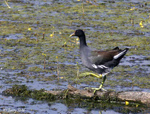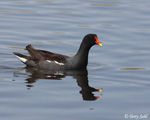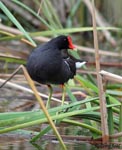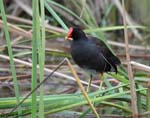Common Gallinule
Gallinula chloropus
| Length: 14 inches | Wingspan: 20 to 22 inches | Seasonality: Summer / Migrant (rare) |
| ID Keys: Red bill with yellow tip and red forehead "shield", dark head and heck, olive-brown upperparts | ||
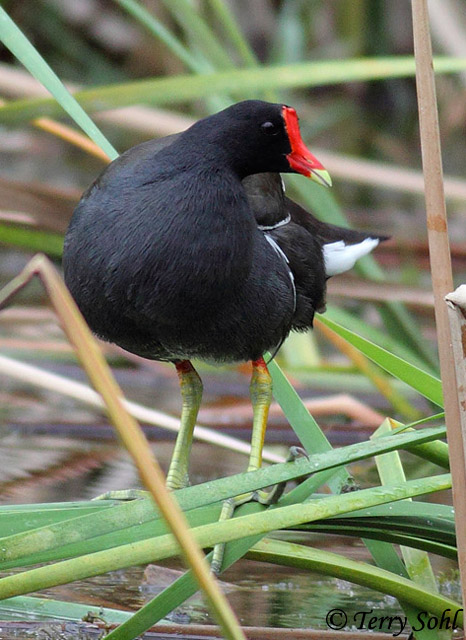 The Common
Gallinule is a
widely spread bird, found on every continent except Australia and
Antarctica. They are often found with their close relative, the American
Coot, but are usually more shy and retiring. They can easily be
differentiated from the somewhat similar American Coot by the brilliant red
forehead shield and the red bill with yellow tip. Common Gallinule are
generally just casual migrants and visitors to South Dakota, but are more common
residents in areas just to the east and south of the state. Note the
official name of the species has changed multiple times, with the latest change
to Common Gallinule occurring in 2011, from the former "Common Moorhen".
The Common
Gallinule is a
widely spread bird, found on every continent except Australia and
Antarctica. They are often found with their close relative, the American
Coot, but are usually more shy and retiring. They can easily be
differentiated from the somewhat similar American Coot by the brilliant red
forehead shield and the red bill with yellow tip. Common Gallinule are
generally just casual migrants and visitors to South Dakota, but are more common
residents in areas just to the east and south of the state. Note the
official name of the species has changed multiple times, with the latest change
to Common Gallinule occurring in 2011, from the former "Common Moorhen".
Habitat: Prefers freshwater marshes with some open water.
Diet: Omnivorous, feeding on many aquatic plants, fruits and berries of terrestrial plants, earthworms, tadpoles, insects and insect larvae, snails, and occasionally bird eggs.
Behavior: Uses a variety of methods for foraging. Will swim on the water's surface, dabbling at the surface, dipping its head below the water, or sometimes by diving beneath the surface. They also will feed on land, or climb through wetland vegetation in search of food.
Breeding: Generally a non-breeder in South Dakota, although there are scattered records of confirmed breeding. The nest of a Common Gallinule is a platform of wetland vegetation such as reeds and cattails, placed above shallow water in a wetland, or sometimes on the ground near the shoreline. The female usually lays between 6 and 12 eggs, and both parents help to incubate them. When the eggs hatch, both parents help to feed them. The young usually fledge at around 6 or 7 weeks.
Song: Common Gallinule song
Migration: Summers in scattered locations through the eastern third of the U.S., and locally in the southwestern United States. Southwestern populations and those in the deep South may not migrate, while most elsewhere winter near the Atlantic coastline.
Interactive eBird Map: Click here to access an interactive eBird map of Common Gallinule sightings
Similar Species: American Coot, Purple Gallinule
Status: Population and range lower than historical levels due to wetland loss, but still locally common throughout its range. The IUCN lists the Common Gallinule as a species of "Least Concern".
Further Information: 1) USGS Patuxent Bird Identification InfoCenter, Common Gallinule
2) Audubon Guide - Common Gallinule
3) WhatBird - Common Gallinule
Photo Information: December 10th, 2012 - Big Cypress National Reserve, Florida - Terry Sohl
Additional Photos: Click on the image chips or text links below for additional, higher-resolution Common Gallinule photos.
| Click on the map below for a higher-resolution view |
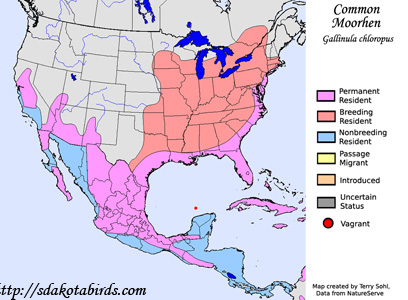 |
| South Dakota Status: Rare visitor and summer breeder, primarily in the eastern part of the state. |
Additional Common Gallinule Photos
Click for a higher-resolution version of these photos
